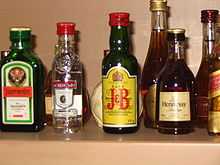Sangria

Sangria is a typical beverage from Spain and Portugal. It normally consists of wine, chopped fruit, a sweetener, and a small amount of added brandy. Chopped fruit can include orange, lemon, lime, apple, peach, melon, berries, pineapple, grape, kiwifruit and mango. A sweetener such as honey, sugar, syrup, or orange juice is added. Instead of brandy, other liquids such as Seltzer, Sprite or 7 Up may be added. Sangria is steeped while chilled for as little as minutes or up to a few days.[1]
The use of the word sangria in labels is now restricted under European law. Only sangria made in Spain and Portugal will be allowed to be sold under that name after the European Parliament green-lighted new wine labeling in January 2014.[2]
Etymology
Sangria is named after the Spanish word for "bloodletting" because of its typical dark-red color.[3]
Variations
Because of the variation in recipes, sangria's alcoholic content can vary greatly, usually from 4 percent up to about 11 percent. The ingredients in sangria vary, particularly in the type of fruit used, the kind of spirits added (if any), and the presence or lack of carbonation.
- White wine can be used instead of red, in which case the result is called sangria blanca or, as in Argentina and Paraguay, clerico. Some recipes that use heavier reds can be lightened by mixing a bottle of white in the mix. In some parts of Southern Spain, sangria is called zurra and is made with peaches or nectarines.[4] In most recipes, wine is the dominant ingredient and acts as a base. In some regions of Portugal, cinnamon and medronho brandy are used.
- Mulled wine can be used to provide a rich full-bodied taste, chilled with orange juice, lemonade and a sliced pear to add sweetness.
- Preparation consists of cutting the fruit in thin slices or small cubes, then mixing in advance all ingredients except for ice and carbonated sodas. After several hours, or a full day in a refrigerator to allow time for the fruit flavors to blend with the rest of the ingredients, the ice and any last-minute ingredients are added and the drinks are poured.
- A non-alcoholic version of sangria is made from wine grapes, carbonated water, essence of lemon, and cane sugar.
- Sangaree (drink) is a similar drink associated with the West Indies and the name sangaree is an archaic English name for sangria itself.[5]
Serving
Sangria is served throughout Spain and Portugal during summer, and in the southern and eastern parts of the countries year-round. In these places it is a popular drink among tourists at bars, pubs and restaurants where it is often served in 1-litre pitchers or other containers large enough to hold a bottle of wine plus the added ingredients. A lid or other strainer for the container helps prevent the fruit and ice cubes from falling into the glass. Among the Spanish and Portuguese, sangria is most typically served at informal social gatherings, much like punch, from a punchbowl. Sangria is often served with a wooden spoon, used to get fruit out of the bottom of the punchbowl or pitcher. Sangria is also commonly served in Cuba, Peru, Mexico, Puerto Rico, Panama, the Dominican Republic, Chile, and Argentina.
Bottled sangria can be bought in some countries. In the parlance of EU administrators, such products are referred to as "aromatised wines".
Sangria has become popular in the UK and the U.S., with many supermarkets stocking it during summer months. Sangría Señorial, a sangria-flavored non-alcoholic soft drink distributed by Tipp under the Jarritos family, has become popular in the United States.
See also
- Mulled wine
- Spritzer
- Tinto de Verano
Notes
- ↑ "Emeril Legasse Sangria #4". FoodNetwork.com. 2005.
- ↑ "EU: True sangria wine comes from Spain, Portugal". The New York Times. 2014-01-14.
- ↑ 5ª edition, Oxford University Press, 1964, Ad v. sangaree
- ↑ Shea, Lisa. "The History of Sangria". Retrieved December 2013.
- ↑ John Ayto. The Glutton's Glossary: A Dictionary of Food and Drink Terms. Routledge, 1990. p. 259.
External links
| Wikimedia Commons has media related to Sangria. |
| ||||||||||||||||||||||||||||||||||||||||||||||||


